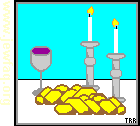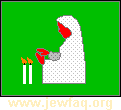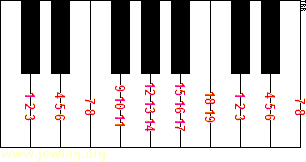| Judaism 101 |
| HOME | IDEAS | PEOPLE | PLACES | THINGS | WORDS | DEEDS | TIMES | LIFE CYCLE | REFERENCE |
The Four ParshiyotThe Four Parshiyot are special Torah readings added to regular weekly Torah readings in preparation for Pesach (Passover). These additional readings come from a different portion of the Torah than the regular weekly reading, and ordinarily require a separate Torah scroll, or at least a strong person to roll the scroll to the extra reading and a patient congregation to wait while he does it! The additional reading is read after the regular weekly reading, and is referred to as the maftir portion. These four Shabbatot are the only ones (other than holidays and Rosh Chodesh) that have an extra Torah portion.Shabbat SheqalimShabbat Sheqalim recalls the census taken in the wilderness, described in Exodus 30:11-16, which is the maftir portion. The people are to donate a half-shekel (a silver coin) as a tax to provide for the maintenance of the Tent of Meeting and its service, and the coins are counted instead of the people.There are many lessons to be learned from this brief passage. The fact that both rich and poor contribute the same amount reminds us that both rich and poor are equally valued in the eyes of the Divine. The fact that we count coins instead of people reminds us that people are not to be thought of as mere numbers on a ledger. The fact that the census contributions are used to maintain the Tent of Meeting reminds us of the importance of contributing to the upkeep of the synagogue (a favorite theme for rabbis!). On Shabbat Sheqalim, we also read a haftarah portion from II Kings 11:17-12:17, which also makes reference to the census money and the use of it for Temple maintenance (see II Kings 12:5-6). Shabbat Sheqalim occurs on the Rosh Chodesh of the month before the month of Nissan (that is, the Rosh Chodesh of Adar or Adar II in leap years), or on the last Shabbat before that Rosh Chodesh. Nissan is the month when Pesach (Passover) occurs. Sheqalim is read at this time because, according to tradition, the half-shekel census was taken on the first of Nissan, and the reading is meant to be a reminder of the upcoming census. Shabbat ZakhorThe reading for Shabbat Zakhor is very troubling for many Jews: a passage commanding us to remember (zakhor) the treachery of Amalek and to blot out their memory. (Deuteronomy 25:17-19). The Amalekites were a tribe of people who came upon the Israelites shortly after their flight from Egypt and attacked them from behind, preying upon the weakest of an exhausted group of people. See Exodus 17:8-16 and Deuteronomy 25:17-19.Many find this commandment troubling because, in ordering us to "blot out the remembrance of Amalek," it appears to advocate genocide, killing people because of their race. Shabbat Zakhor's corresponding haftarah portion (I Samuel 15) is even more explicit on this point, ordering Saul to kill the men, women, children and cattle of Amalek. The sages have long understood the commandment in Parshat Zakhor as a command to blot out the type of peoplethat Amalek represents: those that prey upon the weak, those who do not believe in justice, those who hate without reason. The sages use the term "Amalek" as a shorthand for vicious, evil people who behave like mad dogs, in much the same way that many people today casually toss around the term "Nazi" to refer to anyone they disagree with rather than to Germans or members of the National Socialist party. It is these evil people that we are commanded to destroy, the sages say, not any specific ethnic group. This understanding of the term is quite clear in 15th century Sephardic commentary Me'am Loez, which said, "In every generation Amalek rises to destroy us, and each time he clothes himself in a different nation." In addition, many scholars have suggested that the best way to "blot out" these evil people is to turn them away from their evil. If an Amalekite were to accept basic principles of morality (see The Seven Laws of Noah), the sages say, he would cease to be an Amalekite and would not be someone whose memory we are commanded to blot out. Likewise, someone who chooses to behave in this way becomes an Amalekite whether he is born to that nation or not, as Me'am Loez said. For further discussion of whether Amalek is a racial designation and this is a commandment to genocide, see A Question of Race on Aish.com. Shabbat Zakhor occurs on the Shabbat before Purim, because Haman, the villain of the Purim story, was an Amalekite. The Book of Esther describes Haman as an "Agagite," that is, a descendant of Agag, King of the Amalekites, who was spared by Saul contrary to Divine commandment in the haftarah portion. Shabbat ParahShabbat Parah occurs on the Shabbat following Purim, and marks the beginning of formal preparations for Pesach (Passover). The special Torah reading, Numbers 19:1-22, discusses a ritual of purification involving a red heifer (in Hebrew, parah adumah). Specifically, the ritual purifies people from the ritual impurity that comes from contact with the dead. At the end of the ritual, the people are purified, but the person who performed the ritual becomes temporarily impure.The rabbis speak of the ritual of Parah Adumah as the greatest of mysteries: it makes the impure pure, and makes the pure impure. This proves that the rabbis were all men, because any woman knows that when you clean a house, you start with a clean sponge and a dirty house and you end with a dirty sponge and a clean house, and there is no great mystery in this! The passage is chosen for this time because of the need to purify oneself for Pesach, in preparation for pilgrimage to Jerusalem and the Temple. The corresponding haftarah portion is Ezekiel 36:16-38, which also talks about purification. Shabbat Ha-ChodeshThe last of the Four Parshiyot is Ha-Chodesh, Exodus 12:1-20. With one simple line, it establishes the Hebrew calendar: "This month shall be for you the beginning of the months, it shall be for you the first of the months of the year." (Ex. 12:2).This portion is read on Rosh Chodesh Nissan or on the last Shabbat before Rosh Chodesh Nissan. Now, you may be wondering: why are we reading about the first month of the year in the spring? Isn't Jewish New Year in the fall? On the Hebrew calendar, months are counted from Nissan in the spring, but year numbers change in Tishri (the seventh month) in the fall. The month that is the beginning of months referred to above is Nissan, and this is quite clear from the passage in Exodus, which goes on to talk about preparations for Pesach (Passover), which begins on Nissan 15. The corresponding haftarah portion is Ezekiel 45:16-46:18, which also talks about the first months and the offerings at that time. Other Special ShabbatotA few other Shabbatot receive special notice on the calendar. These Shabbatot have special haftarah readings or have special significance to their standard readings. Unlike the Four Parshiyot above, these Shabbatot do not have special Torah readings and do not require an additional Torah scroll.Shabbat Ha-GadolShabbat Ha-Gadol is the Shabbat before Pesach (Passover). Traditionally, this was one of the few times of the year that a rabbi gave a lengthy sermon (in modern times, we get one every week). The sermon was usually about preparations for Pesach, and this special Shabbat commemorates a preparation for the original Pesach in Egypt. Shabbat Ha-Gadol (The Great Sabbath) commemorates the 10th day of Nissan, when the Hebrew slaves took the lambs that they were going to offer for Pesach and tied them up outside their homes, to keep until they offered it on the 14th (Ex. 12:3-6). According to tradition, this was a dangerous thing to do, because Egyptians worshipped sheep, but miraculously, instead of slaughtering the Hebrews, the Egyptians instead fought with each other over whether the Hebrews should be sent away already.The special haftarah reading for this Shabbat is Malachi 3:4-24. This messianic prophecy regarding the end of days and the return of the prophet Elijah is read at this time because it is believed that Elijah will return at Pesach. This is why we include a cup for him in our seder rituals. Shabbat ShirahUnlike the other special Shabbatot, Shabbat Shirah does not have an additional reading, but rather is dictated by the presence of a standard reading. Shabbat Shirah is the Shabbat when we read Parshat Beshalach (Exodus 13:17-17:16), which is the Torah portion that includes the Song at the Sea.Tradition teaches that there are only ten true Songs (Shirot, the plural of Shirah) in the history of the world. These true Songs are not mere melodies; they are expressions of the harmony of creation and mark monumental transitions in history. Another of these Songs appears on the haftarah portion for the week (Judges 4:4-5:31): the Song of Deborah. The Song of Songs is, of course, one of the Ten Songs. Interestingly, the Tenth Song has not yet been sung: it is the Song of the coming of the Mashiach, which will be sung at the End of Days (see Isaiah 26:1). Shabbat HazonShabbat Hazon means "Sabbath of Vision," and refers to Isaiah's vision of the destruction of the Temple, which is thehaftarah reading for the week (Isaiah 1:1-27). The Torah reading cycle is structured so that the parshah with this haftarah (Parshat Devarim) will occur on the Shabbat preceding Tisha B'Av, a fast day commemorating the destruction of the Temple.Shabbat NachamuShabbat Nachamu means "Sabbath of Consolation." Shabbat Nachamu is the first of seven haftarot starting with the Shabbat after Tisha B'Av and leading up to Rosh Hashanah. These readings are meant to console us after the destruction of the Temple and reassure us that it will be built again. As with Shabbat Hazon, the cycle of Torah readings is structured in such a way that these readings will occur on the appropriate weeks.Shabbat ShuvahShabbat Shuvah literally means "Sabbath of Return," but it is also a play on the phrase "Shabbat Teshuvah" (Sabbath of Repentance). It is the Shabbat that occurs between Rosh Hashanah and Yom Kippur and is a time for reflection leading up to the atonement of Yom Kippur. Shabbat Shuvah has two special haftarah readings, one dealing with the importance of heartfelt repentance (Hosea 14:2-10) and one praising the Creator's mercy (Micah 7:18-20).
© Copyright 5765-5771 (2005-2011), Tracey R Rich
If you appreciate the many years of work I have put into this site, show your appreciation by linking to this page, not copying it to your site. I can't correct my mistakes or add new material if it's on your site. Click Here for more details. |
 The Sabbath (or Shabbat, as it is called in Hebrew) is one of the best known and least understood of all Jewish observances. People who do not observe Shabbat think of it as a day filled with stifling restrictions, or as a day of prayer like the Christian Sabbath. But to those who observe Shabbat, it is a precious gift from
The Sabbath (or Shabbat, as it is called in Hebrew) is one of the best known and least understood of all Jewish observances. People who do not observe Shabbat think of it as a day filled with stifling restrictions, or as a day of prayer like the Christian Sabbath. But to those who observe Shabbat, it is a precious gift from  Shabbat, like all Jewish days, begins at sunset, because in the story of creation in Genesis Ch. 1, you will notice that it says, "And there was evening, and there was morning, one day." From this, we infer that a day begins with evening, that is, sunset. For the precise time when Shabbat begins and ends in your area, consult the list of candle lighting times provided by the
Shabbat, like all Jewish days, begins at sunset, because in the story of creation in Genesis Ch. 1, you will notice that it says, "And there was evening, and there was morning, one day." From this, we infer that a day begins with evening, that is, sunset. For the precise time when Shabbat begins and ends in your area, consult the list of candle lighting times provided by the 